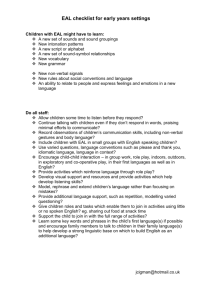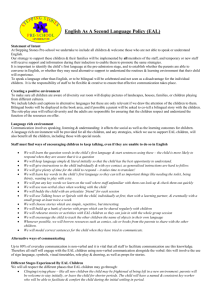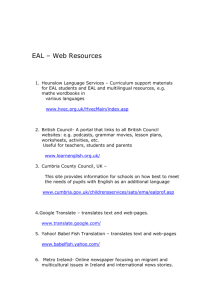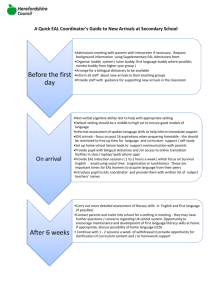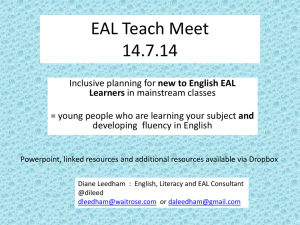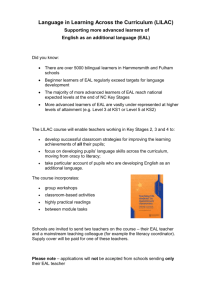E – English as an Additional Language Policy
advertisement
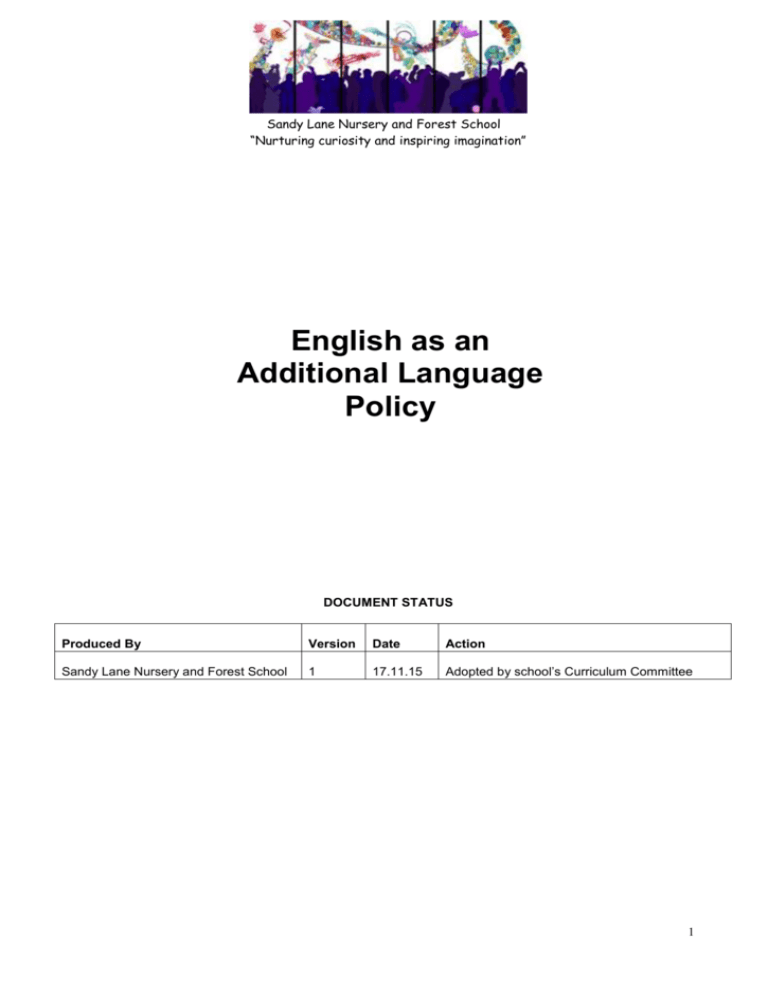
Sandy Lane Nursery and Forest School “Nurturing curiosity and inspiring imagination” English as an Additional Language Policy DOCUMENT STATUS Produced By Version Date Action Sandy Lane Nursery and Forest School 1 17.11.15 Adopted by school’s Curriculum Committee 1 2 Sandy Lane Nursery and Forest School EAL (English as an Additional Language) Policy Statement of intent Sandy Lane Nursery and Forest School undertakes to include all children and to welcome those who are not able to speak or understand English. Its strategy to support these children and their families will be implemented by all members of staff and temporary or new staff will receive support and information during their induction to enable the same strategies. Children attending the school may be monolingual in English or another heritage language, or multilingual and able to understand and speak a number of languages. It is important to identify the child’s first language at the pre-admission stage, which is why the question ‘FIRST LANGUAGE’ is stated on the application form. This will establish whether the parents are able to converse in English or whether they may need alternative support to understand the routines and learning environment that their child will experience. To speak another language other than English or to be multi lingual will be celebrated and not seen as a deficit or disadvantage for the individual children and their family. It is the responsibility of staff to be flexible and creative to ensure that effective communication takes place. Staff differentiate between those children who speak English as an additional language and those who are bilingual by using the following definitions, as provided by the DfE: EAL: English as an Additional Language, recognising the fact that the child is learning English in nursery and may know one or more languages and are adding English to that repertoire Bilingual: Refers to a child who has access to more than one language at home and at school. It does not necessarily imply full fluency in both or all their languages Where a child starts nursery as either EAL or Bilingual, its name will be added to the EAL register and its progress will be monitored and tracked using termly assessments, SALT tracking and Pupil Progress meetings. Creating a positive environment Children from different cultures may find the school environment quite strange: it is important that pictures are included with which the children can identify. These may be of landscapes, houses, families, or children playing. Labels and captions in alternative languages also need to be included but these are only relevant if the children’s attention is drawn to them. Bilingual books will be displayed in the book area and, when possible, a parent will be asked to co-tell a bilingual story with the children or record a simple story for the children to listen to whilst looking at the book with an adult. Staff who can speak an alternative language will be encouraged to use it with the children in a variety of situations. Where possible, dual language games, such as bingo and lotto, will be used. 3 The role-play area will reflect diversity and the adults are responsible for ensuring that the children respect and understand the function of the resources on offer. Language-rich environment Communication involves speaking, listening and understanding: it affects the social as well as the learning outcomes for children. A language-rich environment will be provided for all children and any strategies which are used to support EAL children will also benefit all the children, including those with special needs. Staff must find ways of encouraging children to keep talking, even if they are unable to do so in English Language will be kept simple and literal initially, so that the child has the best opportunity to understand Instructions will be given to the child individually and with eye contact, getting down to the child’s level, as generalised instructions are hard to follow Plenty of time will be given for the child to respond – it takes time to translate! Key words will be learnt in the child’s first language so they can tell staff important things like needing the toilet, being thirsty, wanting to play with a toy Non-verbal clues will be used when working with the child Stories will be chosen which are simple, have clear pictures, are repetitive, but interesting (Farmer Duck, for example) The child will be encouraged to teach the other children the name of objects in their own language Music/story CDs will be borrowed from the family to play to the whole group to enjoy Correct sentences will be modelled for the child when they have tried to communicate Children who share the same home language will be encouraged to spend some time together in the nursery to communicate Alternative ways of communicating Up to 80% of everyday communication is non-verbal and it is vital that this knowledge is used by all staff to facilitate communication. Therefore, all staff will ensure they make their teaching as visual as possible and engage with the EAL children using nonverbal communication alongside the verbal. This will involve the use of MAKATON, other gestures, facial expressions, symbols, visual timetables and photos of the routine, objects and drawing as well as props for stories. Different stages experienced by EAL children The different phases that EAL children may go through will be respected: Clinging/crying phase – like all new children, the child may be frightened of being left in a new environment: parents will be welcome to stay initially or leave the child for shorter periods. The child will have a named key person (as all children do) who will be able to facilitate and comfort the child during the initial settling-in period Watching/silent phase – the child may not want to take part in group activities initially and should be allowed to watch and observe the other children until they are confident to join in 4 Noisy phase – some EAL children will go through a phase of shouting in order to make themselves understood: we encourage them to speak quietly but will acknowledge and praise their efforts to communicate Physical phase – children who cannot communicate in words may become physical in their interaction with other children. Staff will intervene calmly and model appropriate words for the child to learn, such as “I want to play with the...”, “Please can I play too?”, “Can I do that?” Understanding/not speaking phase – staff will recognise that children understand a new language much faster than they can speak it and will therefore always use verbal instructions or comments alongside non-verbal ones Setting boundaries All children quickly recognise the word or symbol for “no” and staff must ensure that the children with EAL are given the same clear boundaries as other children in school. If children consistently fail to understand these, their key worker will approach the parent and ask them to explain them to the child. Working with parents/carers Parents from other countries may have no personal experience of pre-school/early years’ education as we know it. It is important that sufficient time is given for them to understand the key principles of the British system and the routines the children experience. Sandy Lane Nursery and Forest School asks for crucial details before a child starts at the school: country of origin, religion, language and key cultural needs of the child, along with any dietary restrictions; these are all to be shared with the staff team to prevent misunderstandings. Parents are invited to provide a list of key words and phrases or translations of these, to assist the child’s transition into nursery. Any letters sent home will be explained verbally to the parent, where possible translated letters will be available. Parents are encouraged to contribute to the learning of the children by visiting, sharing significant events/festivals and doing activities such as cooking with the children. The school’s website has a translation facility and covers many languages (there is a ‘Select Language’ tab in the top left-hand corner of the screen). Assessment No assumptions should be made of the child’s ability and learning capability based solely on its ability to speak English. Observations by staff members of what a child ‘can do’ will be part of a crucial learning record. Where concerns are exposed through the regular assessment of the child, it will be the responsibility of the key worker to discuss the child’s first language competency with the parents. If this is not age appropriate, the key worker should inform the school’s SENDCo, with a view to referring for further assessment. 5 When the progress of the child in its home language appears appropriate, staff should discuss the needs of the child and whether they need to be encouraged to take up more learning opportunities which are not language dependent. Resources Whenever resources are being ordered, they should be relevant for all the children, including the EAL children: all orders will be discussed by the staff team and, if inappropriate, alternatives will be sought. Responsibilities 1. All staff will be familiar with this policy and be involved in seeing that it is carried out. 2. The headeacher will be responsible for sharing this policy with all new or relief staff. 3. The key person will be responsible for liaising with the parents and monitoring the progress of the individual child. 6
